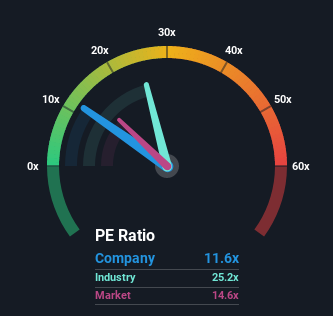Investors Holding Back On Morgan Stanley (NYSE:MS)
With a price-to-earnings (or "P/E") ratio of 11.6x Morgan Stanley (NYSE:MS) may be sending bullish signals at the moment, given that almost half of all companies in the United States have P/E ratios greater than 15x and even P/E's higher than 28x are not unusual. However, the P/E might be low for a reason and it requires further investigation to determine if it's justified.
While the market has experienced earnings growth lately, Morgan Stanley's earnings have gone into reverse gear, which is not great. It seems that many are expecting the dour earnings performance to persist, which has repressed the P/E. If this is the case, then existing shareholders will probably struggle to get excited about the future direction of the share price.
Check out our latest analysis for Morgan Stanley
Want the full picture on analyst estimates for the company? Then our free report on Morgan Stanley will help you uncover what's on the horizon.
How Is Morgan Stanley's Growth Trending?
Morgan Stanley's P/E ratio would be typical for a company that's only expected to deliver limited growth, and importantly, perform worse than the market.
Taking a look back first, the company's earnings per share growth last year wasn't something to get excited about as it posted a disappointing decline of 12%. However, a few very strong years before that means that it was still able to grow EPS by an impressive 50% in total over the last three years. Accordingly, while they would have preferred to keep the run going, shareholders would probably welcome the medium-term rates of earnings growth.
Shifting to the future, estimates from the analysts covering the company suggest earnings should grow by 9.7% per year over the next three years. Meanwhile, the rest of the market is forecast to expand by 9.8% per annum, which is not materially different.
In light of this, it's peculiar that Morgan Stanley's P/E sits below the majority of other companies. Apparently some shareholders are doubtful of the forecasts and have been accepting lower selling prices.
The Bottom Line On Morgan Stanley's P/E
While the price-to-earnings ratio shouldn't be the defining factor in whether you buy a stock or not, it's quite a capable barometer of earnings expectations.
Our examination of Morgan Stanley's analyst forecasts revealed that its market-matching earnings outlook isn't contributing to its P/E as much as we would have predicted. There could be some unobserved threats to earnings preventing the P/E ratio from matching the outlook. At least the risk of a price drop looks to be subdued, but investors seem to think future earnings could see some volatility.
Many other vital risk factors can be found on the company's balance sheet. Take a look at our free balance sheet analysis for Morgan Stanley with six simple checks on some of these key factors.
You might be able to find a better investment than Morgan Stanley. If you want a selection of possible candidates, check out this free list of interesting companies that trade on a P/E below 20x (but have proven they can grow earnings).
Have feedback on this article? Concerned about the content? Get in touch with us directly. Alternatively, email editorial-team (at) simplywallst.com.
This article by Simply Wall St is general in nature. We provide commentary based on historical data and analyst forecasts only using an unbiased methodology and our articles are not intended to be financial advice. It does not constitute a recommendation to buy or sell any stock, and does not take account of your objectives, or your financial situation. We aim to bring you long-term focused analysis driven by fundamental data. Note that our analysis may not factor in the latest price-sensitive company announcements or qualitative material. Simply Wall St has no position in any stocks mentioned.
Join A Paid User Research Session
You’ll receive a US$30 Amazon Gift card for 1 hour of your time while helping us build better investing tools for the individual investors like yourself. Sign up here

 Yahoo Movies
Yahoo Movies 
